
- •I/o Bound: spends more time doing I/o than computations, many short cpu bursts
- •Issues include: thread cancellation, signal handling (synchronous/asynchronous), handling thread-specific data, and scheduler activations.
- •Void Swap (boolean *a, boolean *b){
- •Internal Fragmentation: allocated memory may be slightly larger than requested memory
- •Valid and invalid bits can be used to protect memory
- •Volume contains file system: also tracks file system's info in device directory or volume table of contents
- •In a file sharing system User iDs and Group iDs help identify a user's permissions
- •Increase efficiency by grouping blocks into clusters - Disk I/o is performed on blocks
- •I/o is a major factor in system performance – demand on cpu, context switching, data copying, network traffic
Study Guide to Accompany Operating Systems Concepts 8th Ed by Silberschatz, Galvin and Gagne
By Andrew DeNicola, BU ECE Class of 2012
Figures Copyright © John Wiley & Sons 2012
Ch.1 - Introduction
An OS is a program that acts as an intermediary between a user of a computer and the computer hardware
Goals: Execute user programs, make the comp. system easy to use, utilize hardware efficiently
Computer↔OS↔Applicationssystem:↔Users↔='uses')Hardware(
OS is:
Resource allocator: decides between conflicting requests for efficient and fair resource use
Control program: controls execution of programs to prevent errors and improper use of computer
Kernel: the one program running at all times on the computer
Bootstrap program: loaded at power-up or reboot
Stored in ROM or EPROM (known as firmware), Initializes all aspects of system, loads OS kernel and starts execution
I/O and CPU can execute concurrently
Device controllers inform CPU that it is finished w/ operation by causing an interrupt
Interrupt transfers control to the interrupt service routine generally, through the interrupt vector, which contains the addresses of all the service routines
Incoming interrupts are disabled while another interrupt is being processed
Trap is a software generated interrupt caused by error or user request
OS determines which type of interrupt has occurred by polling or the vectored interrupt system
System call: request to the operating system to allow user to wait for I/O completion
Device-status table: contains entry for each I/O device indicating its type, address, and state
OS indexes into the I/O device table to determine device status and to modify the table entry to include interrupt
Storage structure:
Main memory – random access, volatile
Secondary storage – extension of main memory That provides large non-volatile storage
Disk – divided into tracks which are subdivided into sectors. Disk controller determines logical interaction between the device and the computer.
Caching – copying information into faster storage system
Multiprocessor Systems: Increased throughput, economy of scale, increased reliability
Can be asymmetric or symmetric
Clustered systems – Linked multiprocessor systems
Multiprogramming – Provides efficiency via job scheduling
When OS has to wait (ex: for I/O), switches to another job
Timesharing – CPU switches jobs so frequently that each user
can interact with each job while it is running (interactive computing)
Dual-mode operation allows OS to protect itself and other system components – User mode and kernel mode
Some instructions are only executable in kernel mode, these are privileged
Single-threaded processes have one program counter, multi-threaded processes have one PC per thread
Protection – mechanism for controlling access of processes or users to resources defined by the OS
Security – defense of a system against attacks
User IDs (UID), one per user, and Group IDs, determine which users and groups of users have which privileges
-
-
-
-
-
-
C
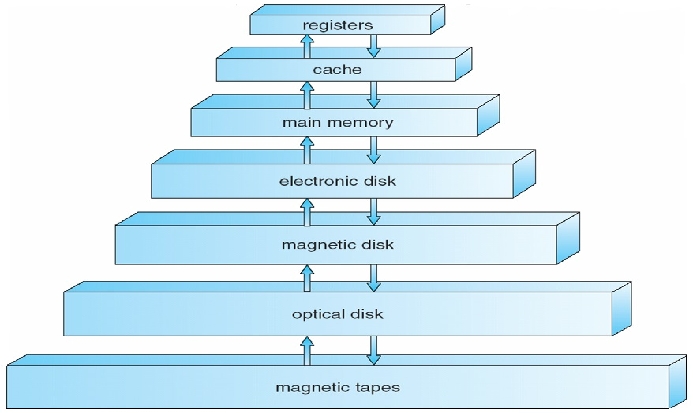 h.2
– OS Structures
h.2
– OS Structures
-
-
-
-
-
User Interface (UI) – Can be Command-Line (CLI) or Graphics User Interface (GUI) or Batch
These allow for the user to interact with the system services via system calls (typically written in C/C++)
Other system services that a helpful to the user include: program execution, I/O operations, file-system manipulation, communications, and error detection
Services that exist to ensure efficient OS operation are: resource allocation, accounting, protection and security
Most system calls are accessed by Application Program Interface (API) such as Win32, POSIX, Java
Usually there is a number associated with each system call
System call interface maintains a table indexed according to these numbers
Parameters may need to be passed to the OS during a system call, may be done by:
Passing in registers, address of parameter stored in a block, pushed onto the stack by the program and popped off by the OS
Block and stack methods do not limit the number or length of parameters being passed
Process control system calls include: end, abort, load, execute, create/terminate process, wait, allocate/free memory
File management system calls include: create/delete file, open/close file, read, write, get/set attributes
Device management system calls: request/release device, read, write, logically attach/detach devices
Information maintenance system calls: get/set time, get/set system data, get/set process/file/device attributes
Communications system calls: create/delete communication connection, send/receive, transfer status information
OS Layered approach:
The operating system is divided into a number of layers (levels), each built on top of lower layers. The bottom layer (layer 0), is the hardware; the highest (layer N) is the user interface
With modularity, layers are selected such that each uses functions (operations) and services of only lower-level layers
Virtual machine: uses layered approach, treats hardware and the OS kernel as though they were all hardware.
Host creates the illusion that a process has its own processor and own virtual memory
Each guest provided with a 'virtual' copy of the underlying computer
Application failures can generate core dump file capturing memory of the process
Operating system failure can generate crash dump file containing kernel memory
C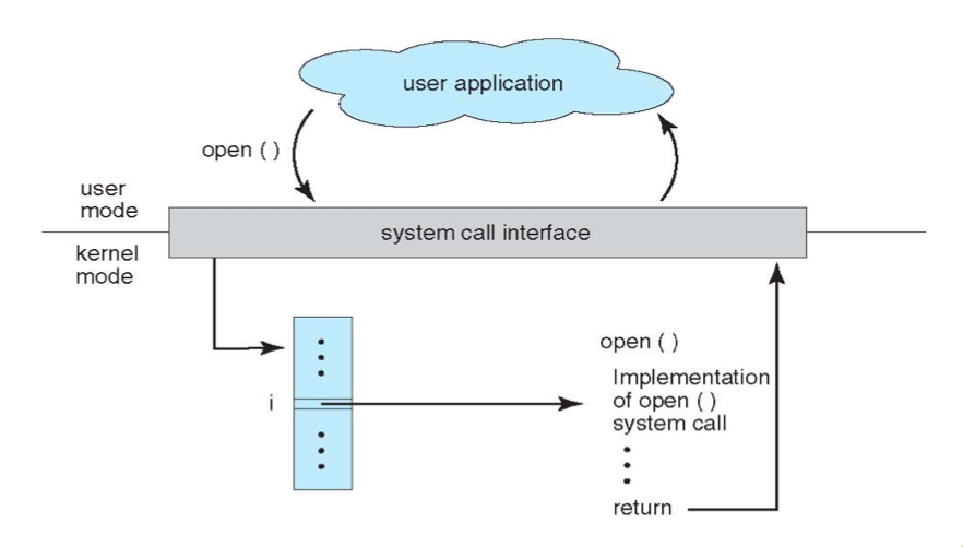 h.3
– Processes
h.3
– Processes
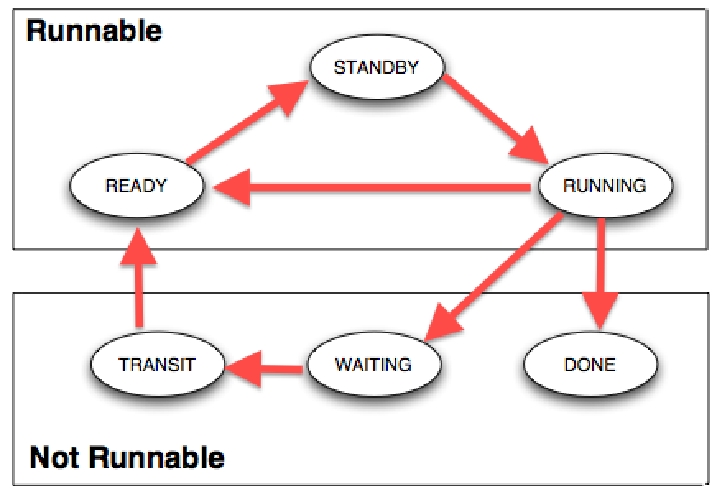
Process contains a program counter, stack, and data section.
Text section: program code itself
Stack: temporary data (function parameters, return addresses, local variables)
Data section: global variables
Heap: contains memory dynamically allocated during run-time
Process Control Block (PCB): contains information associated with each process: process state, PC, CPU registers, scheduling information, accounting information, I/O status information
Types of processes:
I/o Bound: spends more time doing I/o than computations, many short cpu bursts
CPU Bound: spends more time doing computations, few very long CPU bursts
When CPU switches to another process, the system must save the state of the old process (to PCB) and load the saved state (from PCB) for the new process via a context switch
Time of a context switch is dependent on hardware
Parent processes create children processes (form a tree)
PID allows for process management
Parents and children can share all/some/none resources
Parents can execute concurrently with children or wait until children terminate
fork() system call creates new process
exec() system call used after a fork to replace the processes' memory space with a new program
Cooperating processes need interprocess communication (IPC): shared memory or message passing
Message passing may be blocking or non-blocking
Blocking is considered synchronous
Blocking send has the sender block until the message is received
Blocking receive has the receiver block until a message is available
Non-blocking is considered asynchronous
Non-blocking send has the sender send the message and continue
Non-blocking receive has the receiver receive a valid message or null
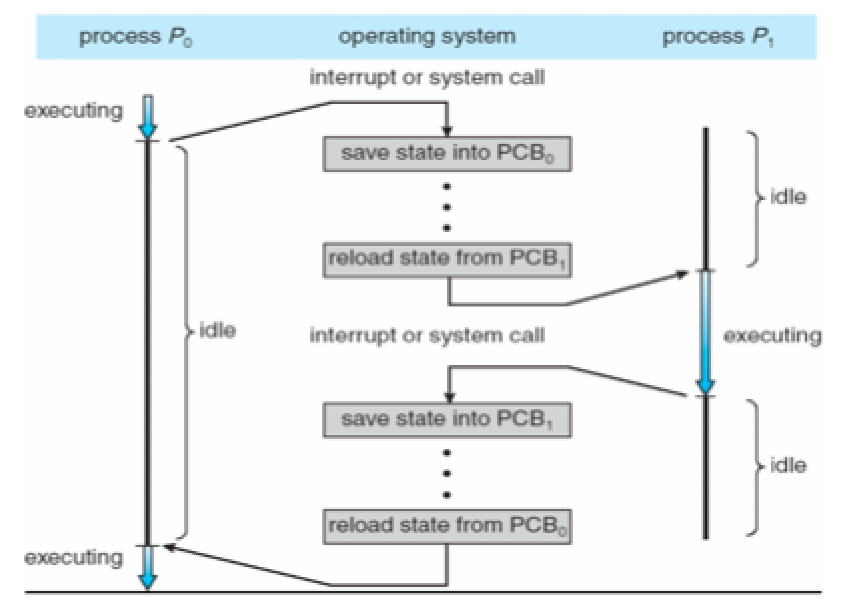
Ch.4 – Threads
Threads are fundamental unit of CPU utilization that forms the basis of multi-threaded computer systems
Process creation is heavy-weight while thread creation is light-weight
Can simplify code and increase efficiency
Kernels are generally multi-threaded
Multi-threading models include: Many-to-One, One-to-One, Many-to-Many
Many-to-One: Many user-level threads mapped to single kernel thread
One-to-One: Each user-level thread maps to kernel thread
Many-to-Many: Many user-level threads mapped to many kernel threads
Thread library provides programmer with API for creating and managing threads
Issues include: thread cancellation, signal handling (synchronous/asynchronous), handling thread-specific data, and scheduler activations.
Cancellation:
Asynchronous cancellation terminates the target thread immediately
Deferred cancellation allows the target thread to periodically check if it should be canceled
Signal handler processes signals generated by a particular event, delivered to a process, handled
Scheduler activations provide upcalls – a communication mechanism from the kernel to the thread library.
Allows application to maintain the correct number of kernel threads
Ch.5 – CPU Scheduling
Process execution consists of a cycle of CPU execution and I/O wait
CPU scheduling decisions take place when a process:
Switches from running to waiting (nonpreemptive)
Switches from running to ready (preemptive)
Switches from waiting to ready (preemptive)
Terminates (nonpreemptive)
The dispatcher module gives control of the CPU to the process selected by the short-term scheduler
Dispatch latency- the time it takes for the dispatcher to stop one process and start another
Scheduling algorithms are chosen based on optimization criteria (ex: throughput, turnaround time, etc.)
FCFS, SJF, Shortest-Remaining-Time-First (preemptive SJF), Round Robin, Priority
Determining length of next CPU burst: Exponential Averaging:
tn = actual length of nth CPU burst
τn+1 = predicted value for the next CPU burst
α,≤α≤01 (commonlyαsetto1/2)
4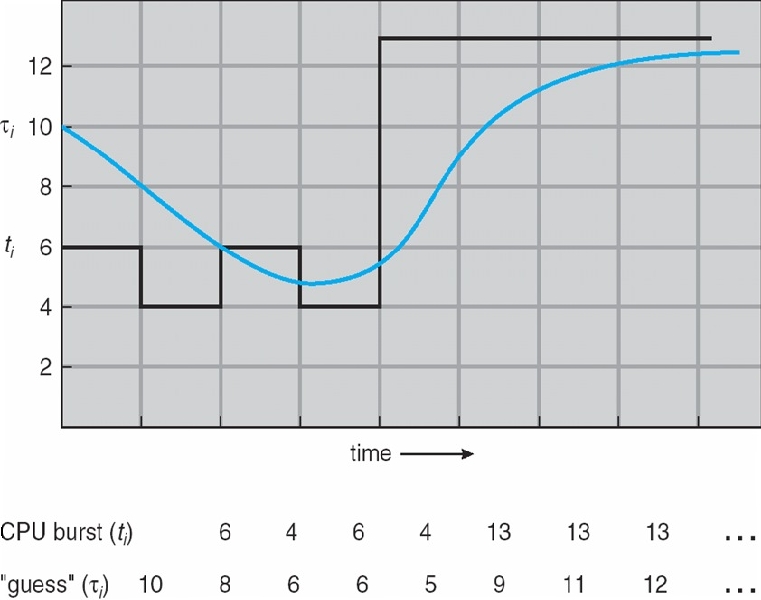 . Define:
τn+1
=α*t n
+ (1-α)τ n
. Define:
τn+1
=α*t n
+ (1-α)τ n
Priority Scheduling can result in starvation, which can be solved by aging a process (as time progresses, increase the priority)
In Round Robin, small time quantums can result in large amounts of context switches
Time quantum should be chosen so that 80% of processes have shorter burst times that the time quantum
Multilevel Queues and Multilevel Feedback Queues have multiple process queues that have different priority levels
◦ In the Feedback→Processesqueue,canpriority is not fixed be promoted and demoted to different queues
Feedback queues can have different scheduling algorithms at different levels
Multiprocessor Scheduling is done in several different ways:
Asymmetric multiprocessing: only one processor accesses system data structures→no need to data share
Symmetric multiprocessing: each processor is self-scheduling (currently the most common method)
Processor affinity: a process running on one processor is more likely to continue to run on the same processor (so that the processor's memory still contains data specific to that specific process)
Little's Formula can help determine average wait time per process in any scheduling algorithm:
n = λ x W
◦ n = avg queueλ=length;averageWarrival=avg waitingrateintotime in queue; queue
Simulations are programmed models of a computer system with variable clocks
Used to gather statistics indicating algorithm performance
Running simulations is more accurate than queuing models (like Little's Law)
Although more accurate, high cost and high risk
Ch.6 – Process Synchronization
Race Condition: several processes access and manipulate the same data concurrently, outcome depends on which order each access takes place.
Each process has critical section of code, where it is manipulating data
To solve critical section problem each process must ask permission to enter critical section in entry section, follow critical section with exit section and then execute the remainder section
Especially difficult to solve this problem in preemptive kernels
Peterson's Solution: solution for two processes
◦ Two processes share two variables: int turn and Boolean flag[2]
turn: whose turn it is to enter the critical section
flag: indication of whether or not a process is ready to enter critical section
▪ flag[i] = true indicates that process Pi is ready
◦ Algorithm for process Pi: do {
flag[i] = TRUE; turn = j;
while (flag[j] && turn == j) critical section
flag[i] = FALSE; remainder section
} while (TRUE);
Modern machines provide atomic hardware instructions: Atomic = non-interruptable
Solution using Locks:
do {
acquire lock
critical section release lock
remainder section
} while (TRUE);
Solution using Test-And-Set: Shared boolean variable lock, initialized to FALSE


do {
boolean TestAndSet (boolean *target){
while ( TestAndSet (&lock ))
boolean rv = *target;
; // do
*target = TRUE;"
nothing
return rv:
// critical section
}
lock = FALSE;
 remainder
section } while (TRUE);
remainder
section } while (TRUE);
Solution using Swap: Shared bool variable lock initialized to FALSE; Each process has local bool variable key
